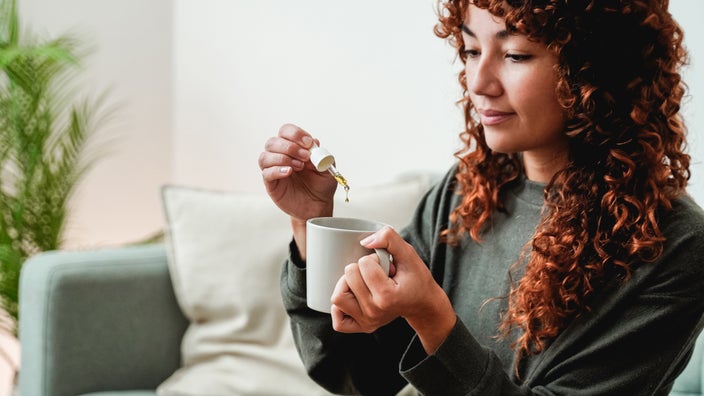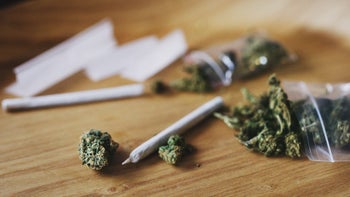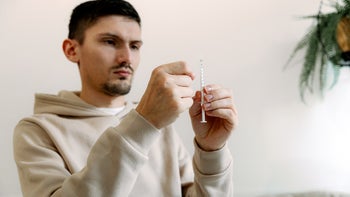
Does CBD Get You High? Effects of CBD on the Brain and Body
Key takeaways:
Cannabidiol (CBD) is considered psychoactive, since it affects your brain. But it won’t make you feel “high” the way that THC does.
CBD is only FDA approved to treat certain types of seizures, but many people take CBD over the counter for symptoms such as pain, insomnia, and anxiety.
CBD doesn’t carry a risk for dependence and misuse. But it does have side effects and drug interactions to consider. So it’s best to speak to a healthcare professional before trying it.
Table of contents

Cannabidiol, or CBD, is one of over 100 natural compounds (cannabinoids) found in the cannabis plant. CBD products have become increasingly popular over the past few years. But there’s still a lot of confusion around what CBD does and whether it can get you high.
Here, we’ll answer these questions and more as we discuss how CBD affects your brain and body when you consume it.
Does CBD get you high?
No, CBD on its own won’t make you feel intoxicated, commonly referred to as “being high.”
Search and compare options
To understand why, it helps to know a bit about how your brain works. Your brain has many types of receptors (binding sites). Think of them like light switches for your body. When a receptor gets turned on or off, it can make things happen — such as changing your mood or how your body feels.
Tetrahydrocannabinol (THC) makes you feel high by binding to the cannabinoid 1 receptor (CB1) in the brain. CBD, on the other hand, doesn’t activate the CB1 receptor. This is why THC (and other cannabinoids that activate CB1 receptors) can make you feel high, but CBD doesn’t.
According to the World Health Organization, CBD also doesn't carry a risk of misuse or dependence — more on this later.
Keep in mind that this applies to CBD on its own. But many over-the-counter (OTC) CBD products contain more than just CBD. And since CBD products aren’t well regulated, some may contain THC or other intoxicating ingredients, even if they’re not listed on the label.
Is CBD psychoactive?
Yes, although CBD isn’t intoxicating, it is psychoactive.
Psychoactive substances are anything that affects your brain and changes your mood, feelings, or behavior. For example, caffeine is considered psychoactive because it makes you feel more alert.
How does CBD oil make you feel? These firsthand experiences offer insights from three people.
CBD dosages: Here’s a review of the FDA-approved dosages for Epidiolex, along with general dosing recommendations for OTC CBD products.
Tips for buying CBD: Follow these pharmacist-backed tips to help protect your safety when purchasing over-the-counter CBD products.
Studies show that CBD may help reduce anxiety, improve mood, and lessen psychotic symptoms. These effects mean that it’s a psychoactive substance, even though it isn’t intoxicating.
CBD’s effects on the brain and body
Experts are still exploring exactly how CBD works in the brain and body. As mentioned, CBD doesn’t activate the CB1 receptor. Current research shows that CBD works by affecting other receptors, including:
Serotonin receptors: These help regulate your mood. This may be how CBD reduces anxiety and depression symptoms.
GABA receptors: These help regulate your nervous system. CBD enhances their activity, which may play a role in CBD’s anti-anxiety and anti-seizure effects.
GPR55 receptors: These seem to play several roles in the body, including contributing to inflammation, pain, and immune system activity. CBD blocks this receptor, which may help reduce inflammation and manage autoimmune conditions. It may also contribute to CBD’s anti-seizure effects. Researchers are studying if CBD’s effect on GPR55 receptors could also help protect against osteoporosis (weak bones).
PPAR𝛄 receptors: These play a role in inflammation. CBD turns on this receptor, which seems to help control inflammation. It may also help manage symptoms of conditions such as multiple sclerosis and Alzheimer's disease.
TRPV1 receptors: These play a role in pain and heat sensations. This seems to be the main pathway for CBD’s pain-reducing effects.
Read more like this
Explore these related articles, suggested for readers like you.
If all these receptor names sound confusing, here’s the simple takeaway: CBD interacts with your body in many complex and unique ways to help you feel more balanced and relaxed — all without making you high.
What are the potential benefits of CBD?
Because CBD interacts with many receptors throughout the brain and body, it’s being studied for a variety of different health conditions. However, not everyone experiences the same benefits, and some studies show conflicting evidence. More human studies are needed to fully understand CBD’s effects, especially over the long term.
CBD is currently only FDA approved as Epidiolex, a medication for certain types of seizure disorders.
CBD products sold OTC don’t have any FDA-approved uses. But people typically turn to them for symptoms such as:
Pain
Inflammation-related conditions, such as arthritis or inflammatory bowel conditions
Again, there’s no clear evidence that CBD is effective for these conditions. And there are side effects and drug interactions to consider. So if you’re considering trying CBD, it’s always a good idea to talk with a healthcare professional first. They can help you decide if it’s a safe and suitable option for your needs.
What about the effects of CBD with THC?
CBD on its own works differently than CBD combined with other cannabinoids, such as THC.
For example, cannabis products with both THC and CBD may work better for nerve or inflammatory pain than CBD alone. Healthcare professionals who specialize in cannabis often recommend you try adding THC if CBD is not an effective treatment by itself.
CBD may also help reduce some of THC’s side effects, such as anxiety and paranoia. Using cannabis products with an equal amount of CBD and THC (a 1:1 ratio) may allow you to experience the benefits of THC without feeling intoxicated. Again, everyone responds differently to cannabis. So it’s best to seek guidance from a trained medical professional when choosing the right cannabis product for your needs.
How long do the effects of CBD last?
The effects of CBD change depending on how you consume it. CBD is available in many forms, including gummies and edibles, sublingual and inhaled products, as well as topical creams.
Your body processes CBD differently depending on how you consume it. The chart below shows the average time it takes for different CBD products to start working, and how long the effects typically last.
CBD Product | Time to start working | How long it lasts |
|---|---|---|
Oral capsules, gummies, and edibles | 1-2 hours | |
Sublingual (under the tongue) tincture or oil | 15-45 minutes | 6-8 hours |
Inhaled (smoking or vaping) | 5-10 minutes | 2-4 hours |
There isn’t a standard CBD dosage that’s recommended (unless you’re taking Epidiolex). Most experts recommend starting with a low dose of CBD, such as 5 mg twice a day, and increasing it over time. This will help you find the right dose for your individual needs. Keep in mind that some conditions, such as anxiety, may require 300 mg to 600 mg of CBD per day.
Is CBD addictive?
No, CBD doesn’t carry a risk for dependence or misuse the way that cannabis products containing THC do.
One clinical study compared different doses of CBD with other medications that have known potential for misuse as well as a placebo (sugar pill). It found no potential for misuse with a 750 mg dose of CBD. Very high CBD doses (1500 mg and 4500 mg) did seem to have a small pleasurable effect. But they scored significantly lower than the controlled substances they were compared with as far as having a potential for misuse.
In fact, CBD is being researched as a possible treatment for substance use disorders. But we need more information to know whether or not it would be effective for this use.
Frequently asked questions
No, CBD isn’t a hallucinogen. It won’t cause you to see, hear, or feel things that aren’t real. Some examples of hallucinogens include LSD, DMT, and psilocybin (mushrooms).
CBD is better known for its calming and relaxing effects. But low doses of CBD may have a stimulating effect for some people. In most cases, it’s recommended to start with a low dose of CBD and increase it over time until you find the right dose for your needs.
The bottom line
Cannabidiol (CBD) is one of the main active compounds in cannabis. It’s a psychoactive chemical, but it doesn’t cause an intoxicating “high” the way that tetrahydrocannabinol (THC) does. That’s because CBD interacts differently than THC with the receptors (binding sites) in your brain.
CBD is only FDA approved for certain seizure conditions under the brand name Epidiolex. But people often turn to over-the-counter CBD products for symptoms such as anxiety, pain, and insomnia. CBD doesn’t carry a risk for dependence or misuse. But it does have side effects and drug interactions to be aware of. So it’s best to talk to a healthcare professional before trying CBD to ensure it’s safe and appropriate for your needs.
Why trust our experts?



Keep in mind that cannabis is legal in some states for recreational and/or medicinal use, but not in others. Cannabis is still illegal under federal law. Before you use cannabis products, find out the laws in your state.
References
Arnold, J. C. (2022). The safety and efficacy of low oral doses of cannabidiol: An evaluation of the evidence. Clinical and Translational Science.
Bakas, T., et al. (2017). The direct actions of cannabidiol and 2-arachidonoyl glycerol at GABAA receptors. Pharmacological Research.
Balenga, N. A. B., et al. (2011). GPR55 regulates cannabinoid 2 receptor-mediated responses in human neutrophils. Cell Research.
Bhaskar, A., et al. (2021). Consensus recommendations on dosing and administration of medical cannabis to treat chronic pain: Results of a modified Delphi process. Journal of Cannabis Research.
Castillo-Arellano, J., et al. (2023). The polypharmacological effects of cannabidiol. Molecules.
Esposito, G., et al. (2011). Cannabidiol reduces Aβ-induced neuroinflammation and promotes hippocampal neurogenesis through PPARγ involvement. PLOS One.
Ganesh, S., et al. (2023). Delta-9-tetrahydrocannabinol, cannabidiol, and acute psychotomimetic states: A balancing act of the principal phyto-cannabinoids on human brain and behavior. Cannabis and Cannabinoid Research.
Henson, J. D., et al. (2022). Tetrahydrocannabinol and cannabidiol medicines for chronic pain and mental health conditions. Inflammopharmacology.
Khajuria, D. K., et al. (2023). Cannabidiol and cannabigerol, non-psychotropic cannabinoids, as analgesics that effectively manage bone fracture pain and promote healing in mice. Journal of Bone and Mineral Research.
Kicman, A., et al. (2020). The effects of cannabidiol, a non-intoxicating compound of cannabis, on the cardiovascular system in health and disease. International Journal of Molecular Sciences.
MacCallum, C. A., et al. (2018). Practical considerations in medical cannabis administration and dosing. European Journal of Internal Medicine.
Marichal-Cancinoa, B. A., et al. (2017). Advances in the physiology of GPR55 in the central nervous system. Current Neuropharmacology.
Melas, P. A., et al. (2021). Cannabidiol as a potential treatment for anxiety and mood disorders: Molecular targets and epigenetic insights from preclinical research. International Journal of Molecular Sciences.
Ng, T., et al. (2023). Tetrahydrocannabinol (THC). StatPearls.
Nichol, K., et al. (2019). The proposed multimodal mechanism of action of cannabidiol (CBD) in epilepsy: modulation of intracellular calcium and adenosine-mediated signaling (P5.5-007). Neurology.
Oberbarnscheidt, T., et al. The impact of cannabidiol on psychiatric and medical conditions. Journal of Clinical Medicine Research.
Paulus, V., et al. (2022). Cannabidiol in the context of substance use disorder treatment: A systematic review. Addictive Behaviors.
Schoedel, K. A., et al. (2018). Abuse potential assessment of cannabidiol (CBD) in recreational polydrug users: A randomized, double-blind, controlled trial. Epilepsy & Behavior.
Schouten, M., et al. (2024). Cannabidiol and brain function: Current knowledge and future perspectives. Frontiers in Pharmacology.
ScienceDirect. (n.d.). Psychoactive substance.
Solowij, N., et al. (2019). A randomised controlled trial of vaporised Δ9-tetrahydrocannabinol and cannabidiol alone and in combination in frequent and infrequent cannabis users: acute intoxication effects. European Archives of Psychiatry and Clinical Neuroscience.
Sommerville, K. W., et al. (2023). Chapter 15 - Cannabidiol (CBD): Abuse and physical dependence potential. Cannabis Use, Neurobiology, Psychology, and Treatment.
United States Drug Enforcement Administration. (n.d.). Hallucinogens.
World Health Organization. (2014). Glossary of terms used in these guidelines. Community Management of Opioid Overdose.
World Health Organization. (2018). Cannabidiol (CBD): Critical review report.
Keep in mind that cannabinoids are legal in some states for personal and/or medicinal use, but not in others. Certain cannabinoids are still illegal under federal law.




























